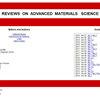Mechanically sustainable and primary recycled thermo-responsive ABS–PLA polymer composites for 4D printing applications: Fabrication and studies
IF 3.9
4区 材料科学
Q2 MATERIALS SCIENCE, MULTIDISCIPLINARY
引用次数: 0
Abstract
3D printing is one of the plastic recycling processes that deliver a mechanically sustainable product and may be used for 4D printing applications, such as self-assembly, sensors, actuators, and other engineering applications. The success and implementation of 4D printing are dependent on the tendency of the shape memory with the action of external stimuli, such as heat, force, fields, light, and pH. Acrylonitrile butadiene styrene (ABS) and polylactic acid (PLA) are the most common materials for fused filament fabrication-based 3D printing processes. However, the low-shaped memory tendency on heating and weaker and less rigidity of ABS limit the application domains. PLA is an excellent responsive behavior when the action of heat has high stiffness. The incorporation of PLA into ABS is one of the solutions to tune the shape memory effect for better applicability in the 4D printing domain. In this study, the primary recycled PLA was incorporated into the primary recycled ABS matrix from 5 to 40% (weight%), and composites were made by extrusion in the form of cylindrical filaments for 4D printing. The tensile and shape memory properties of the recycled ABS–PLA composites were investigated to select the best combination. The results of the study were supported by fracture analysis by shape memory analysis, scanning electron microscopy, and optical microscopy. This study revealed that the prepared ABS–PLA-based composites have the potential to be applied in self-assembly applications.用于 4D 打印应用的机械可持续性和初级回收热响应 ABS-PLA 聚合物:制造与研究
三维打印是塑料回收工艺之一,可提供机械上可持续的产品,并可用于四维打印应用,如自组装、传感器、致动器和其他工程应用。4D 打印的成功和实施取决于形状记忆在热、力、场、光和 pH 值等外部刺激作用下的变化趋势。丙烯腈-丁二烯-苯乙烯(ABS)和聚乳酸(PLA)是基于熔融长丝制造的三维打印工艺中最常见的材料。然而,ABS 在加热时的低形状记忆倾向和较弱的刚性限制了其应用领域。而聚乳酸在热作用下具有很高的刚度,反应性能极佳。在 ABS 中加入 PLA 是调整形状记忆效果的解决方案之一,可更好地应用于 4D 打印领域。在本研究中,将初级回收聚乳酸加入初级回收 ABS 基质中,加入量为 5% 至 40%(重量百分比),并通过挤压制成圆柱丝状复合材料,用于 4D 打印。研究了再生 ABS-PLA 复合材料的拉伸和形状记忆性能,以选择最佳组合。研究结果得到了形状记忆分析、扫描电子显微镜和光学显微镜断裂分析的支持。该研究表明,制备的 ABS-PLA 基复合材料具有自组装应用的潜力。
本文章由计算机程序翻译,如有差异,请以英文原文为准。
求助全文
约1分钟内获得全文
求助全文
来源期刊

Reviews on Advanced Materials Science
工程技术-材料科学:综合
CiteScore
5.10
自引率
11.10%
发文量
43
审稿时长
3.5 months
期刊介绍:
Reviews on Advanced Materials Science is a fully peer-reviewed, open access, electronic journal that publishes significant, original and relevant works in the area of theoretical and experimental studies of advanced materials. The journal provides the readers with free, instant, and permanent access to all content worldwide; and the authors with extensive promotion of published articles, long-time preservation, language-correction services, no space constraints and immediate publication.
Reviews on Advanced Materials Science is listed inter alia by Clarivate Analytics (formerly Thomson Reuters) - Current Contents/Physical, Chemical, and Earth Sciences (CC/PC&ES), JCR and SCIE. Our standard policy requires each paper to be reviewed by at least two Referees and the peer-review process is single-blind.
 求助内容:
求助内容: 应助结果提醒方式:
应助结果提醒方式:


